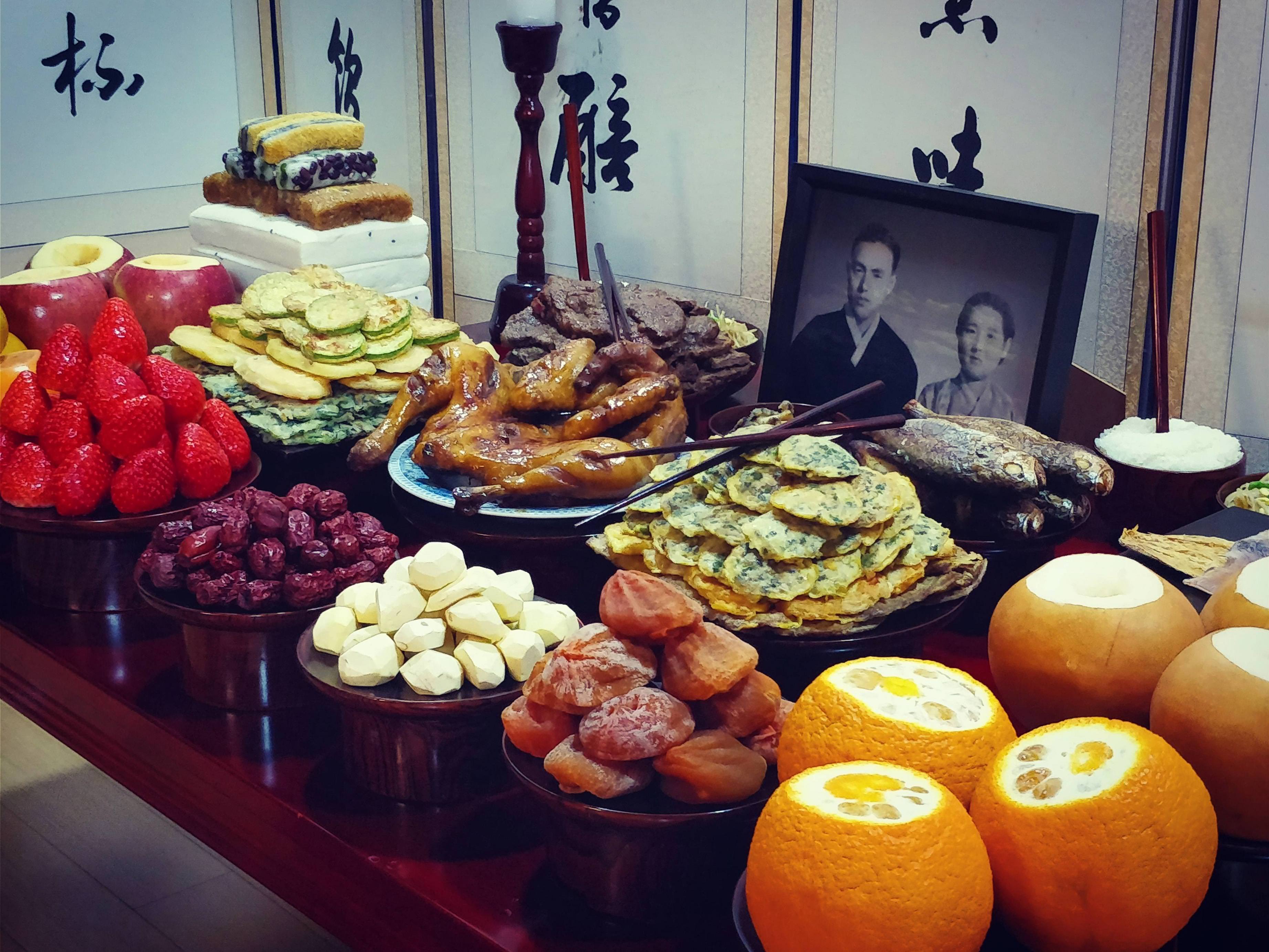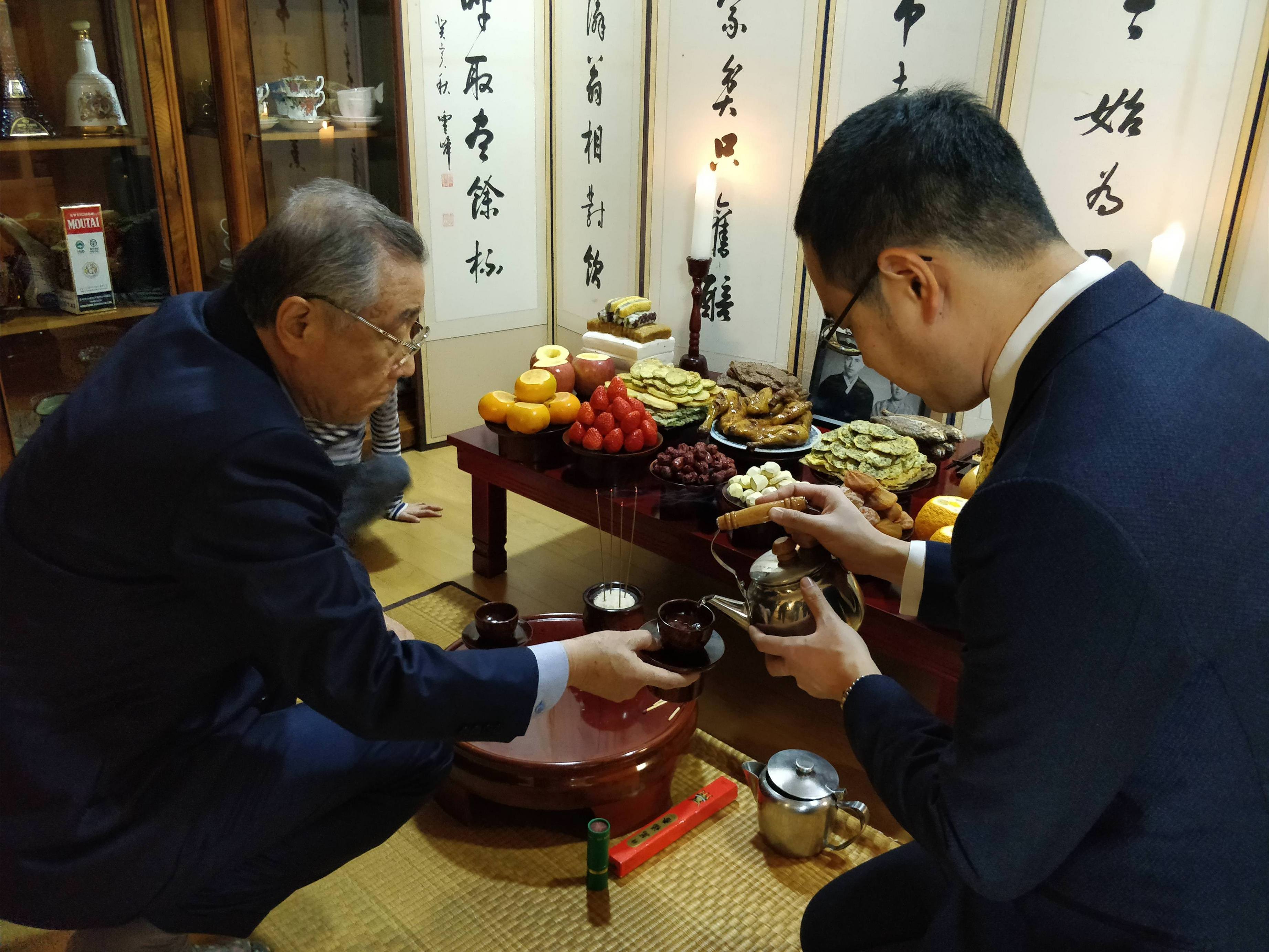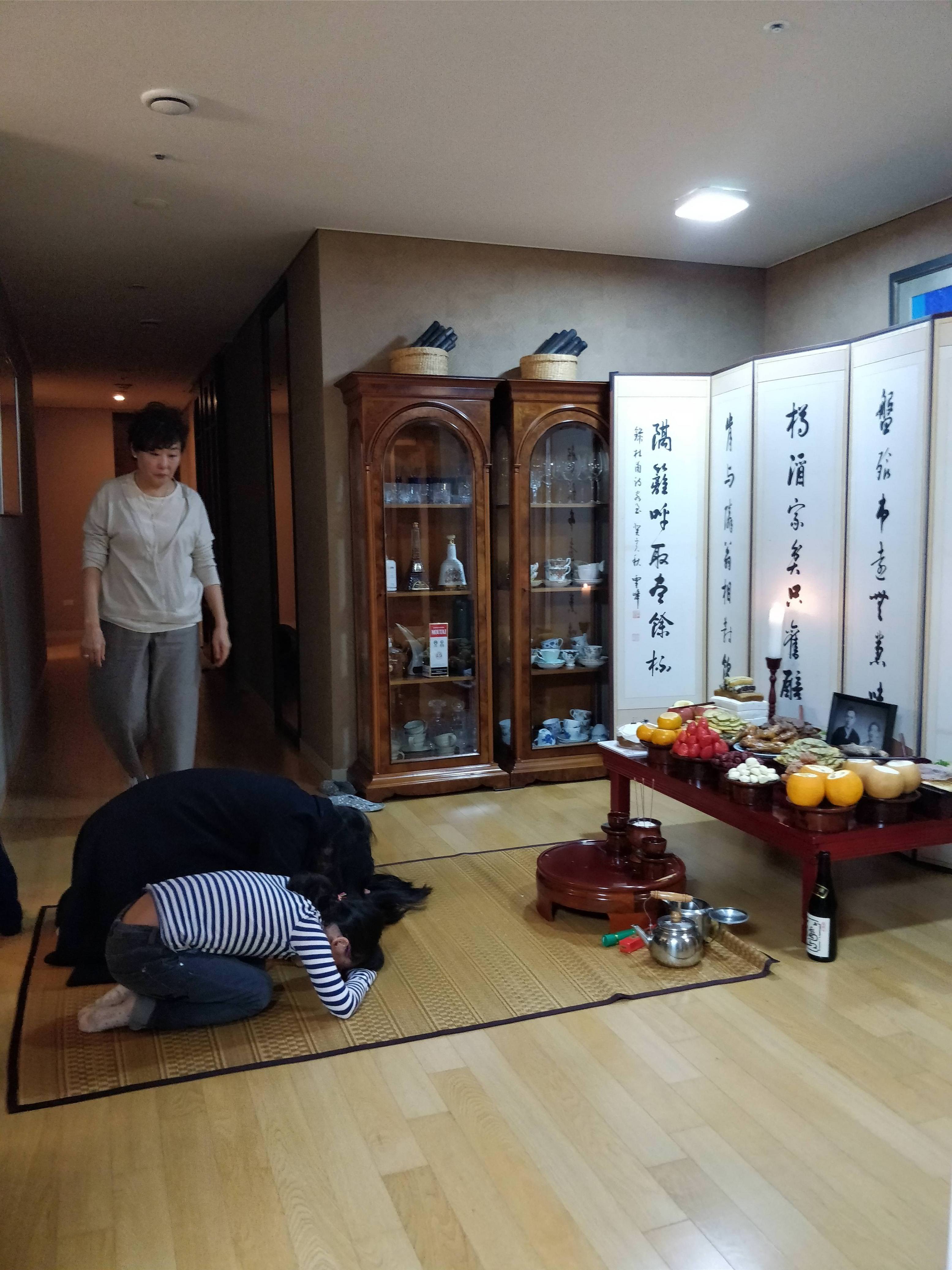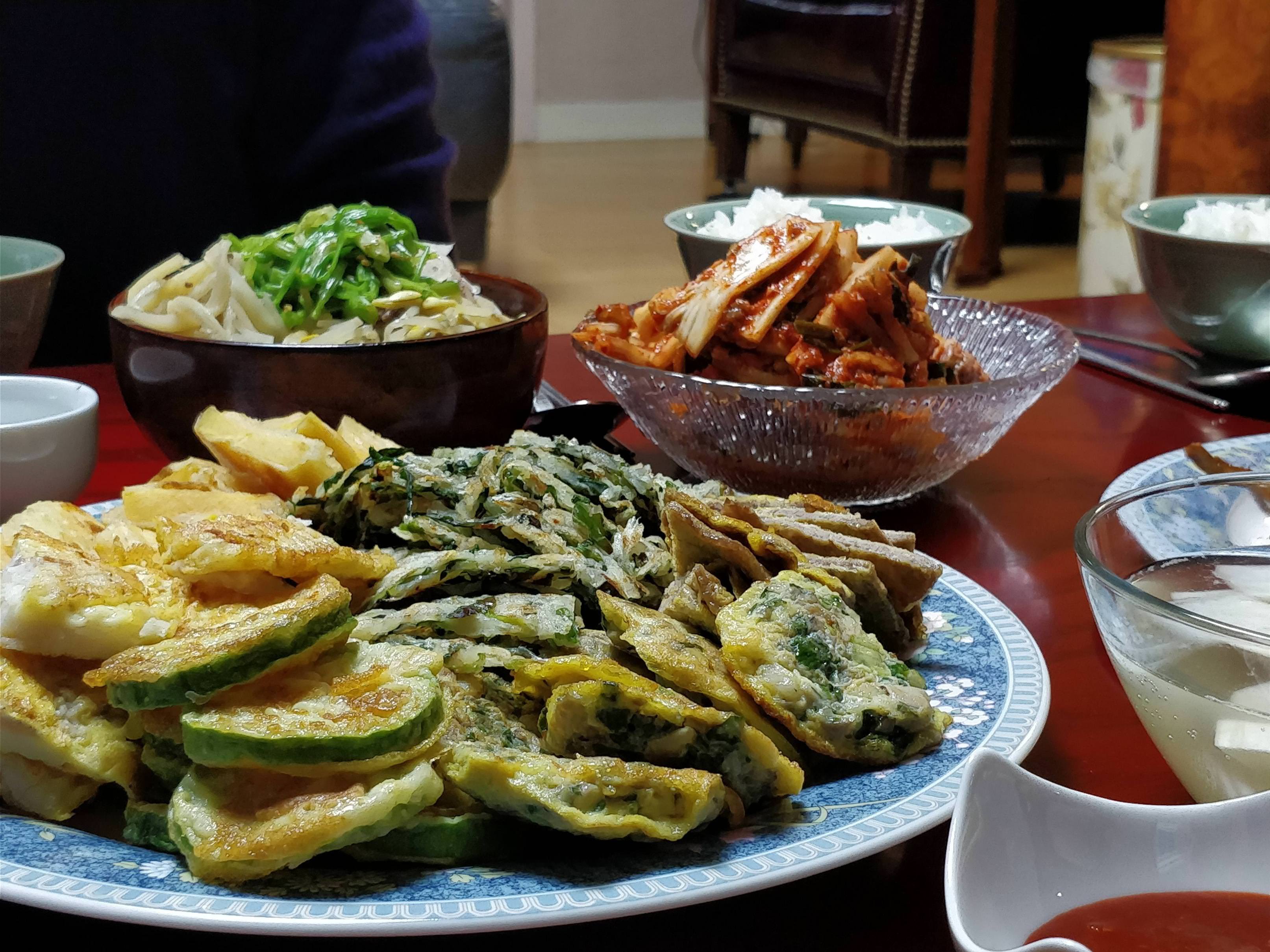In Korea, we commemorate and nourish the spirits of our ancestors by offering special foods during the Mid-Autumn Festival, Lunar New Year, and another for a specific elder's death anniversary called Jesa.
My great-grandmother passed in 2009 and every year since then we, as her descendants, will gather to honor her on this day. This is a semi-shamanistic practice that Korean Christian Protestants view as pseudo-religious and don’t allowed to be practiced, but the majority of Korean Buddhists and Catholics will often make offerings to the deceased several times a year (there’s a fascinating historical footnote: the Pope in 1939 declared Confucianism a philosophy and thus its rites were of a civil and cultural nature, thus allowing the funeral rites to be practiced under Catholicism).
在韩国我们有祭祀与供奉祖宗的传统,主要是在过过春节、中秋节、和去世忌日的时候。曾祖母于2009年去世,自此之后每年她的子孙将集合祭拜她。这可以说是一种类似萨满教的礼仪,因此新教徒(Protestants)是不会举行的,反而佛教徒和天主教徒会举行这种祭祀(有趣的历史注脚:1939年的教宗颁布儒家思想是一种哲学而非宗教,礼仪算是文化或人民的事情,因而罗马教廷允许教徒进行祭祖仪式)。
 My Great-Grandmother // 증조할머니(왕할매)제삿날 // 曾祖母之祭祀
My Great-Grandmother // 증조할머니(왕할매)제삿날 // 曾祖母之祭祀1914.01.06-2009.01.06
Pictured above are foods that are often served during what’s known as ancestor veneration or veneration of the dead in Korea. These customs follow guidelines laid down in during the Zhou Dynasty (c. 1046 BC–256 BC) and were later promoted by Confucius himself, at least according to the Analects (“He sacrificed to the dead, as if they were present. He sacrificed to the spirits, as if the spirits were present. The Master said, "I consider my not being present at the sacrifice, as if I did not sacrifice.”). In Confucianism, only the eldest son could be entrusted with these sacrificial rituals, and the entire family line would be considered destroyed if there were no sons among their descendants; the paternalistic society only valued men, and vestiges of this heritage still exist in East Asian cultures today. For those interested in researching this history further, ctext.org is an invaluable resource of translated texts, and if anyone knows where I can read more on these topics formally, please let me know. For now, let me share more of what I witnessed and learned from my father.
上面是韩国祖先祭拜时供奉的食物。这个传统可以追溯至中国的周代。孔曾在论语中也写到(“祭如在,祭神如神在。子曰:「吾不與祭,如不祭。」”)。在儒家的概念中,只有长子才可以举行祭祀;若后背没有子嗣,这个家谱就断了。过去的父系社会只重视男性,而且古文化的痕迹还存在于现代的东亚文化中。如果大家想进一步研究这个历史,ctext.org 是一个很有价值的双语参考。如果大家知道我如何研究这个话题,请多多指教。
 Pouring alcohol as an offering // 倒供奉的米酒
Pouring alcohol as an offering // 倒供奉的米酒 Notice that fruits are peeled and chopsticks set to make it easy for her to come and taste what was prepared with love and piety (we also prop the front door so she can come). This is why you should not stick your chopsticks vertically into your food, as this is reserved for when we pay respects during this ceremony called Jesa; to do this outside of the ceremony brings bad luck or invites death. For the ceremony, we bow head to floor twice, add a short bow, then pour alcohol. We move chopsticks from dish to dish. We give her time to eat. Then we repeat twice more. Traditional foods include 枣栗梨柿 (dates chestnuts pears persimmons), seafood, rice cakes, and favorite foods (ours is the smashed chicken). Once respect has been paid, we set the table and enjoy the feast. She remains in our hearts and she still brings family together during these rituals. This is the essence of filial piety; in Chinese, the character depicts a child supporting the elders, and this has been a pillar of both Chinese and other Asian countries that were touched by Confucian ideas. There is a saying that Of all virtues, filial piety is the first (百善孝為先), and these death anniversary feasts are one embodiment of a culture that heavily emphasizes duty towards ones parents and ancestors.
注意水果是半剥的,筷子放得让灵魂可以更加容易想用孝顺后背准备的美餐 (为了让灵魂进来我们也把门开着)。因此我们平时不要把筷子垂直地放到饭碗里;这是祭祀时才会做的。开始举行祭祀的时候,我们先叩拜两次,鞠躬一次,再倒酒。我们重复做两次。传统食物必须包括枣栗梨柿,再可以加咸鱼、年糕、还有曾祖母最擅长做的菜(上图片的类似于蒸的香酥鸡)。祭祀之后,我们会聚餐,食用供奉的食物。如此一来曾祖母仍存在于我们心中,还在让全家聚集在一起。这是孝顺的本质;“孝”这个字指的是儿子扶持“老”或者上辈的意思;这个概念是儒家国家共有的。中文还有一个说法:百善孝为先。祭祀也是看重孝文化的表现之一。
 *Even the great-great children participate in bowing // 曾孙的孩子也会参与祭拜 *
*Even the great-great children participate in bowing // 曾孙的孩子也会参与祭拜 *  Enjoying the feast after the ceremony // 祭祀结束之后的聚餐
Enjoying the feast after the ceremony // 祭祀结束之后的聚餐 This was the first time I had the opportunity to participate in this specific ceremony in Korea, so if you know anything else I can learn about these customs, please let me know. Thanks for reading.
由于我是在美国长大的,这是我第一次有机会亲身体验忌日举行的祭祀。如果大家对祭祀和祖先祭拜有更加深刻的理解,请不吝赐教。谢谢大家的关注。
#korea #문화 #전통 #의례 #韩国 #祭祀 #礼仪

